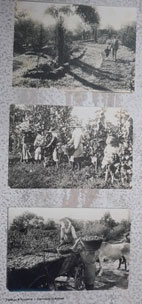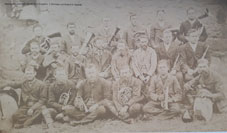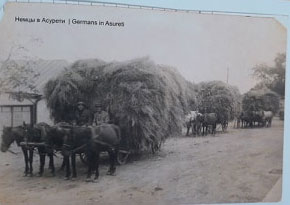
Otto Schall - Country of Liquid Sun
Thursday, May 7
On the verge of eighteenth and nineteenth centuries, Russia significantly extended its borders through wars with Turkey and Iran. This was the period when Georgia also was included within the composition of Russian Empire which enabled Russia to develop the Georgian economy in accordance with its own interests. The main purpose of the Empire was to turn Georgia into a reliable and economically profitable region and it tried to implement this policy by various means.
In the 1840s, the daughter of poor German emigrant, Sofia Frederica Augusta Von Alhald-Zerbsz, married the heir of Russian throne Peter III. She dethroned her husband as soon as he became the Tsar and made herself the Empress of Russia, Frederica Augusta, known as Ekaterina II and as a recognised Germanophile, continuously tried to attract as many Germans as possible and settle them within Russia and its subordinated provinces throughout her half-century reign. She especially facused upon the province located to the south-west of Germany, populated with Swabians, Alemanians from where hundreds of ancient families of Staufens and Zeringens were resettled.
Ekaterina II, who actually prepared the basis for the annexation of Georgia to Russia and signed the so called Tractate of Georgyevsk with the Kartli-Kakhati Kingdom in 1783, was actively seeking contacts-as well as family linkages-with Georgia. Aleksandre Chavchavadze, her godson, was one of the most famous representatives of Georgian Romanticism whose father, Garsevan Chavchavadze, a famous political figure and diplomat himself, also signed the Tractate on Friendship between Russia and Georgia in Georgyevsk.
Later, the process of re-settlement of Germans began in Georgia as well. In 1817-1819, in the period of General Ermolov's rule, Swabian colonists from South Germany-from Vutemberg and Baden-were re-settled in Georgia in an organised manner. They established eight colonies: Marienfpheld (near Sartichala), Tbilisi colony (suburban area on Kukia Street at that time), Alexanderdorf (in Didube), Petersdorf (near Marienfoheld), Elizavetalle (present Asureti), Ekatherinenfpheld (near Bolnisi), Annenphfeld (near Shamkori) and Helennensdorf (near Gyanja).
By the end of the nineteenth century, viticulture and potato farming were quite developed in the village of Elizavetalle in southern Georgia. Grain Crops were also cuftivated there. In the second half of the nineteenth century, when the Germans, who were living in Asureti, formed a strong community, community leaders began to collect money for constructing church. Based upon a design by Albert Salzman, a German architect who was living in Tbilisi, the church was completed in 1871.
The village maintained the name of Elizavetalle until 1914, In the October of that year, the names of German colonies were changed following a circular order of the Ministry of Internal Affairs. Accordingly, the village was returned to its original name of Asureti from Elizavetalle. Other villages also experienced similar name changes.
The increasing economic prosperity of the time facilitated rural development in Georgia and its traces could be seen even in the present appearance of Asureti. There were many social-cultural establishments built: a school, church, cinema, park, bathhouse, outpatient facility, pharmacy, power station, library, village council building, post and telegraph, kindergarten and wine cellar. All of the establishments and buildings had their own functions and performed an important role in the socio-economic and cultural life of the population.
The wine cellar of Elizavetalle was a beautiful building that maintains its charm even today. It is located in some seven kilometers from the village on the bank of the River Algeti in the middle of a vineyard. The building is constructed of grey and white cut stone. It has arched windows and two large upper and lower doors. Its first floor is completely under the ground level whilst the second floor is above the ground. The building covers a half-hectare and its area, including the yard, comprises more than 1.5 hectares.
The second floor of the wine cellar has ten-ton capacity concrete and five-ton capacity wooden barrels for pressing wine. The harvest used to be squeezed manually as well as by means of electric engines. By pumps, and sometimes by its own flow, wine was transferred into the barrels located on the first floor. If a barrel broke or if wine leaked out, it was accumulated in a special basin by means of channels arranged under the barrels, in order to avoid any losses, from which vodka was tater distilled. The well-placed and thrift German technology meant that not even a single drop of wine was lost.
The first floor of the wine cellar gives the impression of an arched tunnel way. Oak and pine barrels, with the capacity from five to 1,000 liters, were located there in three rows.
In 1934-1935, a greenhouse, run by Heinrich Schettle and Ernst Hfau, was constructed near the wine cellar where disease-resistant vine varieties were cultivated. The most important fact is that they revived extinct vine variety of Shala which was found by one of the German colonists, Otto Schall, on the territory of the remains of an old Georgian village, Samachveti, in the forest. Thanks to Schall, this unique vine variety has survived. Shala, which was named after the German colonist, only grows in Asureti (an the agronomist-selectionist of the of the Kakulia's Estate describes it as Asuretuli Shavi or Asuretian Black). As compared with other variet- ies, it has many advantages in that it has high yields and produces a fine black-red wine from its grapes. The German church servants prepare their special wine, required for Holy Communion, from these grapes.
Approximately 5,000 tons of wine were made in the wine cellar. Evgeny Reitenbach, a German colonist living in Azerbaijan, was invited there as a wine maker. He died in 1938 in Asureti after which he was replaced by villager, Robert Bauer.
The Asureti collective farm, named after Lavrenti Beria, had a wine outlet in Tbilisi which was located at 16, Kuti Street as well as in the Avlabari Market and including Baku and Yerevan.





